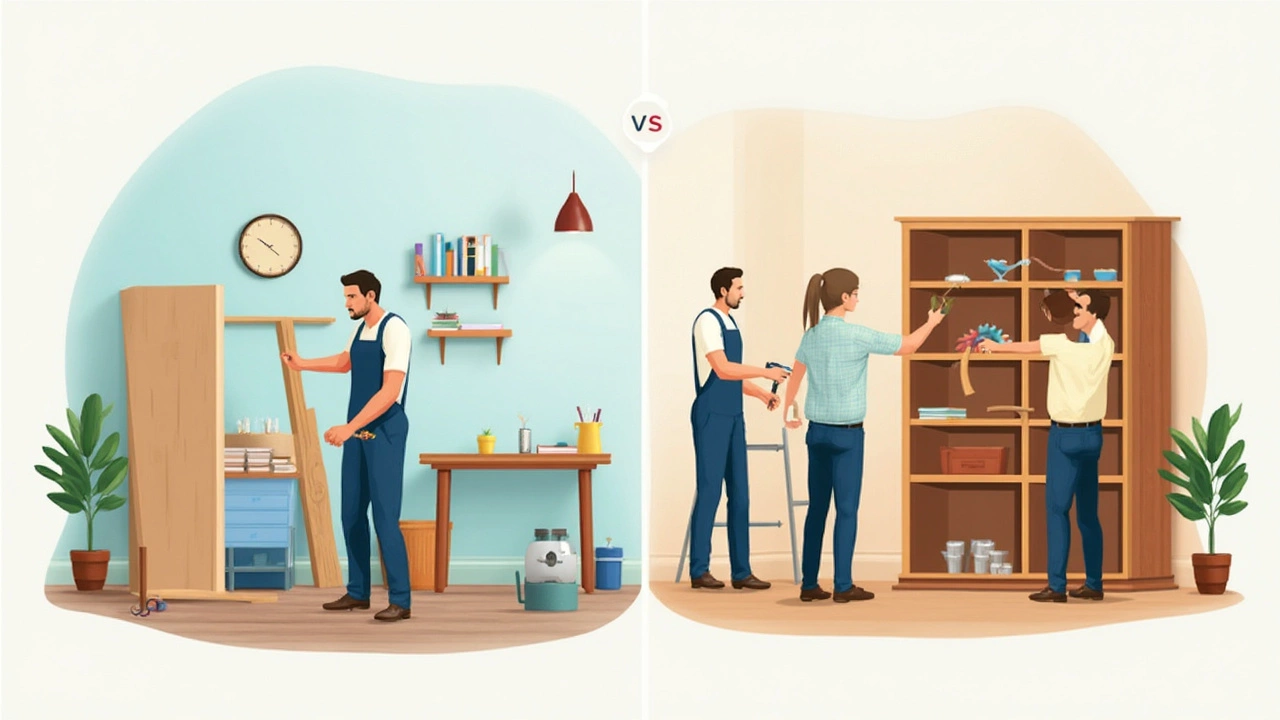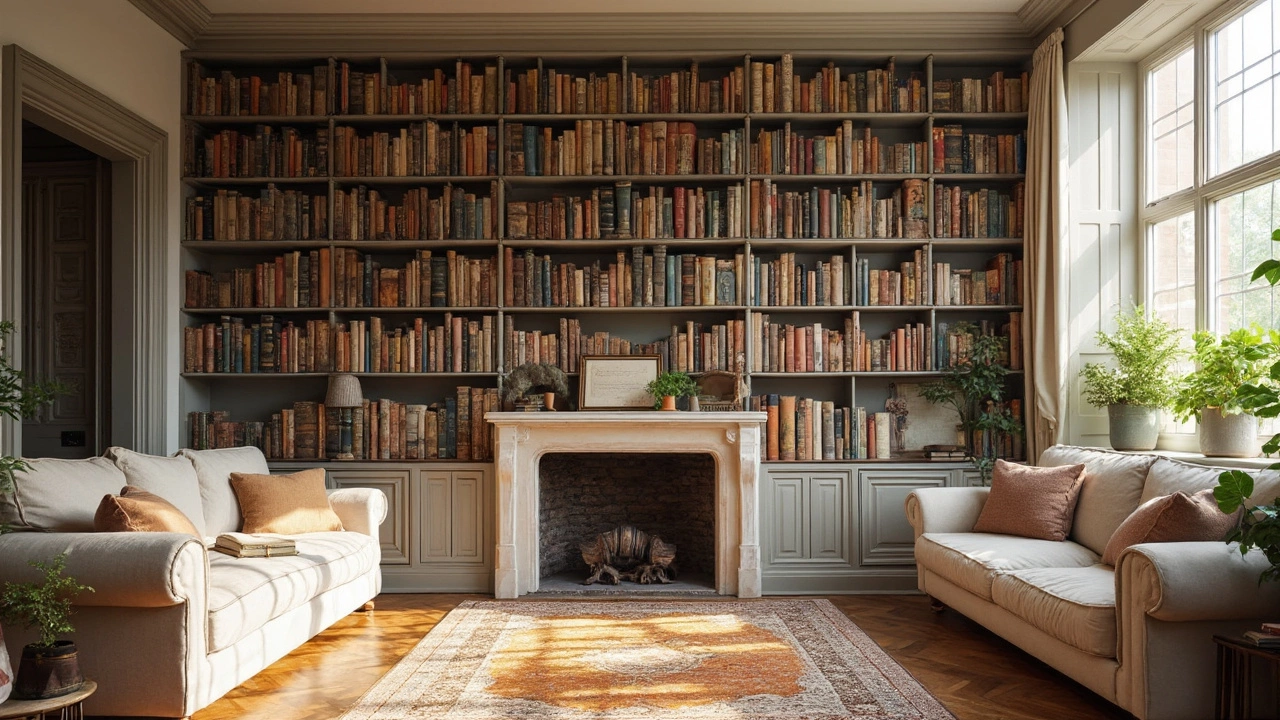Thinking about floor to ceiling bookshelves can be both exciting and a little intimidating once you start wondering about the actual cost. Spoiler: the range is huge, and it really depends on what you want. Are you picturing solid walnut, or will MDF with paint do the trick? Do you want something that fits like a glove around your fireplace, or just a basic wall of shelves for a home office?
The price is almost never just about the shelves themselves. It comes down to labor, materials, design, and a bunch of little details most people don’t see coming. For a pro-built custom set spanning one wall, you could be looking at $2,000 on the low end, all the way up to $10,000 or more if you want fancy wood or custom features. Doing it yourself can chop that cost by more than half—but it’s not always as straightforward as it looks on TikTok.
There are ways to get the built-in look without the custom price, especially if you’re willing to spend a weekend and tackle some assembly yourself. But before you pull out the measuring tape, let’s walk through what goes into that price tag so you know what you’re actually shopping for. You might be able to save a pile of cash—or at least avoid those annoying budget surprises when your bookshelf dream gets real.
- What Drives the Price of Floor to Ceiling Bookshelves?
- DIY vs Hiring a Pro: What Will You Really Save?
- Material Choices: Cheap, Mid-Range, and Luxe Options
- Hidden Costs Most Folks Miss
- Ways to Get the Look Without Blowing Your Budget
What Drives the Price of Floor to Ceiling Bookshelves?
When it comes to floor to ceiling bookshelves, the price isn’t some random number. It usually comes down to a mix of factors—some super obvious, others not so much. First off: the size of your wall. The bigger the shelves, the more materials and time you’ll need. A small nook will cost way less than bookshelves that run the length of your living room.
Material is a game changer. Solid hardwood like oak or walnut costs way more than MDF or plywood—sometimes two to three times as much. If you want a painted finish, MDF works and keeps costs low. For a natural wood look, be ready to pay premium. Glass doors, soft-close drawers, and fancy trims also drive up your total fast.
| Material | Average Cost Per Linear Foot (Pro Install) |
|---|---|
| MDF/Plywood | $250-$400 |
| Painted Solid Wood | $400-$700 |
| High-End Hardwood | $700+ |
Custom work is pricier than anything pre-made. If you need the shelves to fit around a fireplace, reach up to a ten-foot ceiling, or fit in an awkward corner, expect a bump in labor charges. Intricate designs or extra deep shelves add complexity and cost, too.
Don’t forget finishing. A basic “paint and done” is one thing, but if you want hidden lighting, built-in ladders, or cabinet doors, those add up quickly. And if you live in a city or an area where contractors charge a lot more per hour, the same bookshelf could cost double what it does in a small town.
Here’s a quick recap of what really sets the price for bookshelf installation cost:
- Size/Wall area: Bigger space = more money.
- Material type: MDF and plywood are cheapest. Solid wood is most expensive.
- Custom shapes or features: More custom stuff means higher labor fees.
- Finishing details: Doors, lighting, molding—all add to the total.
- Location: Contractor rates change depending on where you live.
Knowing these factors helps you spot what’s really driving the price on that builder’s quote—or figure out where you might want to flex your DIY muscles to save cash.
DIY vs Hiring a Pro: What Will You Really Save?
When it comes to floor to ceiling bookshelves, the do-it-yourself route looks way cheaper than calling in the pros. But how much are you really saving—and what's the tradeoff?
If you buy raw materials (like MDF or plywood) and do everything yourself, you might spend between $300 and $1,000 total for a decent-sized wall, supplies included. Compare that to hiring a professional carpenter, which usually starts at around $2,000 and can easily climb past $7,500 or more if you want custom touches.
| Option | Typical Cost (8 ft wall) | Timeline |
|---|---|---|
| DIY | $300 - $1,000 | 1-2 weekends |
| Professional | $2,000 - $7,500+ | 2-4 days (plus wait list) |
Going DIY gets you bragging rights—and some serious savings if you already have the basic tools. But it's not all upside:
- Skill matters. If you’ve never installed shelving, there's a learning curve. Custom built-ins require precise measuring, cutting, leveling, and often some creative problem-solving (like dealing with crooked walls).
- Time adds up fast. What looks like a few hours on YouTube can take days when it's your first time, especially if mistakes happen.
- Tools cost money. If you don’t already own a saw, drill, level, and stud finder, getting started might eat into your budget pretty fast. Renting tools is an option, but quality gear makes a difference.
- Finish quality. Pros do this all day, every day. If you want slick edges, perfect paint, and smooth seams, pro work usually looks more polished.
- Custom work. Got weird room angles or want to integrate lighting and ladder rails? A pro will make it happen, but it'll cost you.
On the flip side, hiring a pro means you skip the grunt work, avoid rookie mistakes, and end up with a more flawless final product. The cost reflects years of experience, insurance, proper materials, and way less stress on your part.
If saving money is your #1 goal and you’re pretty handy, DIY bookshelf installation is hard to beat. But if you only want to do this once and never think about it again, hiring out gives you peace of mind—and likely a better resale value if you ever move.

Material Choices: Cheap, Mid-Range, and Luxe Options
The cost of floor to ceiling bookshelves jumps around, mostly because of the material. If you want to keep your budget in check, or if you’re aiming for that statement-maker library look, picking the right stuff matters a lot. Here’s how the options shake out, from cheap to fancy:
- Cheapest: MDF (medium-density fiberboard) or particleboard is about as wallet-friendly as it gets. Pre-cut boards from big box stores can get you a wall of shelves for $250–$600, depending on height and width. Most basic prefab shelves use this stuff. They hold up fine for books, as long as you don’t overload them, but they can swell if exposed to too much moisture.
- Mid-Range: Plywood or real wood veneer is a step up in strength and looks. Custom plywood shelving (painted or with a thin hardwood top layer) lands around $700–$2,000 for a full wall, depending on details. Actual birch or maple plywood is strong, lasts years, and stands up to most scuffs. These are a favorite for people who want lasting value without going wild on cost.
- Luxe Options: Solid hardwood (like walnut, cherry, or oak) jumps into the $3,000–$10,000 range if you want custom fit, rich grains, and fancy moldings. These are for folks who see bookshelves as furniture that will outlive the house itself. They boost your home’s value and just look amazing, but they’ll cost you plenty.
Quick tip: If you see shelves labeled “wood,” check if it’s actually solid or just veneer. That makes a big difference both for cost and how much weight they can hold.
Some folks mix it up—using plywood for the inner shelves and a fancy hardwood face frame. That can cut your costs by 30% or more while still looking top-tier.
| Material | Price Range (Wall Unit) | Pros | Cons |
|---|---|---|---|
| MDF/Particleboard | $250–$600 | Low price, easy to paint, easy to replace or adjust | Less durable, can warp with moisture, not fancy |
| Plywood/Veneer | $700–$2,000 | Strong, looks nice, customizable | Costs more, may show wear over time |
| Solid Hardwood | $3,000–$10,000 | Beautiful, super durable, raises home value | Expensive, heavy, labor-intensive |
So, when you’re pricing out bookshelf installation cost, pay close attention to the material. That’s where a huge chunk of your money goes, whether you build or buy.
Hidden Costs Most Folks Miss
When you start adding up the bottom line for floor to ceiling bookshelves, it’s not just about the price of wood and some screws. There are sneaky expenses that catch a lot of people off guard—and these can really add up fast.
One of the first surprises? Prep work. If your wall isn’t perfectly flat or there are baseboards, electrical outlets, or vents in the way, that’s more work. Moving these around or cutting shelves to fit isn’t free and can bump your labor bill up by a few hundred bucks. If you live in an older house, expect a crooked wall or two—your installer will need extra time for custom fitting, and that time isn’t cheap.
Don’t overlook finishing touches. Painting or staining, trim work, and caulking all cost extra. Want built-in lights, cabinets at the bottom, or special molding to make your bookcase look like it’s always been there? Expect to pay for these upgrades. Sometimes, just the paint and hardware for a giant shelving unit can run $200–$400 or more.
Delivery fees for big pieces of custom bookcases can sneak up, too. If your hallway or stairwell is tight, installers might have to build the whole thing in your living room instead of delivering it in one piece. That means extra hours—and extra dollars.
Permits are another surprise in some cities. If you’re screwing something heavy into the wall and it affects electrical or structural stuff, you might need a permit. Permits are rarely more than $100–$300 for shelves, but it’s money some folks forget to add in.
- Removing existing shelves or old built-ins can add labor costs
- Hauling away debris is sometimes a separate fee
- Fixing or patching up walls after install can cost an extra $100—$300
- Protecting your floors and furniture during installation is sometimes billed separately
Here’s a quick look at common hidden add-ons:
| Hidden Cost | Low-End | High-End |
|---|---|---|
| Wall Preparation | $100 | $500 |
| Painting/Staining | $200 | $800 |
| Lighting | $150 | $600 |
| Permit Fees | $100 | $300 |
| Debris Removal | $50 | $250 |
Bottom line? When budgeting for bookshelf installation cost, plan for at least 10–20% extra to handle these little surprises. Almost no one pays exactly what they expect at the start. Being prepared keeps your project (and your wallet) out of trouble.

Ways to Get the Look Without Blowing Your Budget
You don’t have to empty your bank account to pull off floor to ceiling bookshelves. There are some proven hacks that’ll bring that built-in style home with way less cash than fully custom work. Start with retail options—places like IKEA, Home Depot, or even Target. The IKEA BILLY hack is famous for a reason: those units run about $100 a pop (even less on sale), and stacked with trim, paint, and a weekend’s work, they can look seriously high-end.
If you want to go this route, here’s how lots of folks do it:
- Pick up 2-4 basic bookcases that fit your wall's overall width.
- Secure them to studs for safety and stability—don’t skip this step.
- Add MDF trim or flat molding around the edges and at the top for a built-in vibe.
- Caulk the seams and paint everything to match your wall or trim color.
This way, you can get that custom look for closer to $500-$800, compared to several thousand for a pro job. And if you’re handy with a miter saw, you can notch out trim, add baseboards, and even pop in some puck lights for extra effect.
Want an even cheaper option? Look for used shelving units on Facebook Marketplace or Craigslist. Pre-owned ones are usually 30-50% cheaper, and a coat of paint covers a lot of sins.
DIY plywood is also a solid choice. Sheets run about $40–$60 each, and you can cut to fit. A single wall of custom bookcases made this way can land under $1,000 if you do all the labor yourself. Just remember: your time is worth something. If you’re not comfortable with saws and levels, the savings might not be worth the stress.
| Option | Average DIY Cost | Time Required |
|---|---|---|
| IKEA Hack (Billy) | $500–$800 | 1-2 days |
| Used Bookcases | $200–$500 | 1 day |
| Plywood Custom | $700–$1,200 | 2-4 days |
Whatever route you take, here are a few extra tips to keep it budget-friendly:
- Skip real hardwood if you’re painting. MDF and plywood look great with the right finish and cost much less.
- Buy shelves and trim during holiday sales or from surplus building supply stores.
- If you want the built-in shelving effect, carry the trim right up to the ceiling and wrap it around the sides. Going floor to ceiling makes even cheap bookcases look custom.
So yeah, you really can get those floor to ceiling bookshelves on a regular salary. Most of the magic is in the trim work, a good paint job, and having a solid plan before you start.


Write a comment